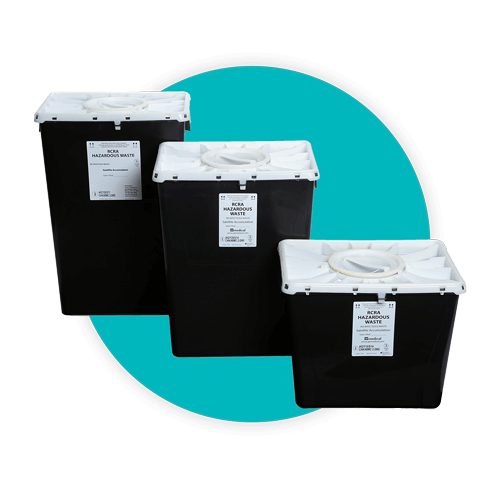Guide to Washington State Medical Waste Regulations

Washington, the Evergreen State, has a population of approximately 7.5 million people, many of whom will occasionally seek medical care or require hospitalization. From outpatient medical services to acute hospital care in facilities located from Seattle to Olympia in the western part of the state to Spokane and smaller communities like Walla Walla in the eastern portion, the residents of the state are well cared for.
That care also produces medical waste streams that must be appropriately identified and disposed of. Understanding proper definitions is the first step in creating and facilitating an effective waste stream management process. Doing so also ensures the safety of healthcare providers, their patients, and the environment.
TOPICS WE WILL COVER:
2 / Where to find Washington’s medical waste regulations
3 / Determining waste generator status for hazardous waste
4 / A word about records, manifests, and tracking
5 / Daniels Health Resources for compliant medical waste management
Defining medical waste
While every state throughout the country must follow the guidelines of the federal government per the Environmental Protection Agency (EPA) and the Resource Conservation and Recovery Act (RCRA) for various waste stream management guidelines, individual states may also have slightly different definitions of medical waste streams as well as their processes for disposal.
For example, in the state of Washington, pathological waste can include but is not limited to biopsy materials, tissues or anatomical parts that result from a surgical procedure, and body tissues. It doesn’t include teeth or anatomical parts intended for cremation or internment, nor human corpses.
Sharps waste is defined as a syringe with a needle attached, scalpel blades and/or lancets that have been removed from their sterile packaging, IV tubing with needles, and all hypodermic needles.
It’s important to know how to define certain waste streams so that they are properly separated or segregated from other waste streams and discarded in appropriate containers. Some medical waste is destined for incineration or other process that renders the waste safe for disposal in a landfill, while other waste streams, such as biomedical waste, must be segregated and treated before disposal off-site.
Your employees need to know the difference between infectious (also known as regulated medical waste) and non-infectious waste. Non-infectious waste can go directly into the garbage or “regular waste” containers. An infectious waste must be handled per the guidelines of local health department requirements.
In some cases, an infectious waste is also a hazardous waste. As an example, a syringe that contains a drug with a regulated component can be considered an infectious waste as well as a hazardous waste, especially if the drug or component in the syringe is found on the P- or U- listed hazardous drugs list of the EPA, such as chemotherapy drugs.
Every employee should be able to identify the most commonly produced or generated waste streams and understand safe and compliant procedures for its handling, storage, and disposal.
Where to find Washington’s medical waste regulations
Washington state medical waste regulations can be found in a number of sources, including the state’s administrative codes, the Occupational Safety and Health Administration (OSHA) state guidelines, and the Washington State Department of Ecology. It is the responsibility of the waste generator to determine whether waste produced is dangerous and to know how to deal with it and dispose of it safely and in compliance with state and federal guidelines.
The Revised Code of Washington (RCW) is also an excellent resource – a compilation of permanent laws currently in force in the state of Washington. For example, RCW Chapter 70.9 5K focuses on biomedical waste and includes definitions, waste treatment technologies, and so forth.
The Department of Ecology also publishes a step-by-step guideline in regard to the usage and management of containers. The document also includes important information pertaining to identification numbers, shipping manifests for hazardous waste, and arranging for transportation and disposal.
Determining waste generator status for hazardous waste
In addition to understanding waste segregation processes, it’s also important to determine your generator status based on the volume of hazardous waste you produce each month. For example:
- A small quantity generator (SQG) produces 220 pounds or less hazardous waste and 2.2 pounds or less of acutely hazardous waste.
- A medium quantity generator (MQG) produces anywhere between 220 and 2,200 pounds of hazardous waste and 2.2 pounds or less of acutely hazardous waste.
- A large quantity generator (LQG) produces 2,200 pounds or more of hazardous waste, and more than 2.2 pounds of acutely hazardous waste.

Be aware of storage time limitations. Per the Department of Ecology, a small quantity generator does not have a time limit for hazardous waste storage, while the medium quantity generator can store hazardous waste for up to 180 days. A large quantity generator cannot store hazardous waste for longer than 90 days.
Hazardous waste generators can find more information for exclusion limits and category determinations in Washington’s Administrative Code 173-303-169. Washington’s dangerous waste regulations can be found in chapters 173 through 303. For example:
- § 173-303-045 – references to EPA’s hazardous waste and permit regulations
- § 173-303-080 – Dangerous waste lists
- § 173-303-090 – Dangerous waste characteristics
- § 173-303-141 – Treatment, storage, or disposal of dangerous waste
- § 173-303-160 – Containers
Additional topics are covered in detail including requirements for manifests, preparation of dangerous waste for transportation, record-keeping and reporting requirements, personnel training, as well as contingency plans and emergency procedures.
Washington’s Department of Ecology also provides an informative publication titled “Guide to Dangerous Waste by Generator Category” that can be accessed here.
A word about records, manifests, and tracking
Washington’s Department of Ecology is focused on ensuring that hazardous wastes reach proper disposal sites. It is important that any waste generator transporting dangerous or hazardous waste be aware of the dangerous waste regulations found in chapter 173 through 303 of Washington’s Administrative Code, which requires use of manifest forms to track hazardous waste, taking the cradle-to-grave approach.
Before hazardous waste is transported off-site, waste generators must fill out a uniform hazardous waste manifest. The form (8700-22) is downloadable from the EPA and can be accessed here.
Daniels Health resources for compliant medical waste management
With so many regulations to keep track of, you need a partner to ensure compliant waste disposal. With decades of experience in the field of medical waste and hazardous waste management processes, Daniels Health offers a number of resources for compliant medical waste management. From containers to segregation and pick-up processes, we support safe and compliant waste segregation procedures that protect healthcare providers as well as the environment. For information regarding our products, services, and compliance expertise, contact one of our knowledgeable representatives today.
Let's Talk!
Your time is valuable, and we don’t want to play hard to get. You can either phone us directly on the details listed on our contact page, or feel free to fill out this short form and one of our team members will get back to you as quickly as possible.
